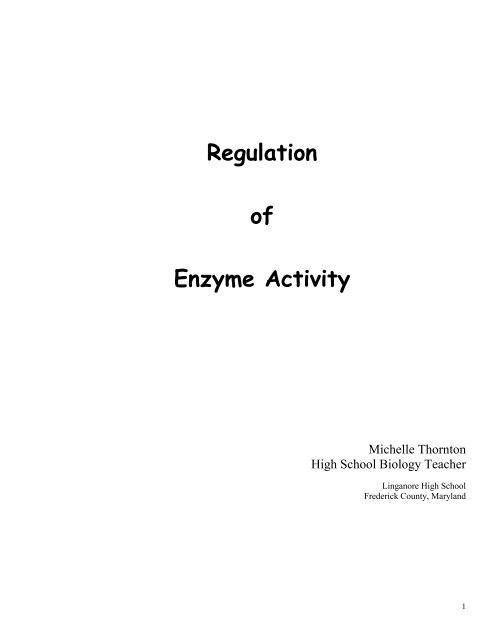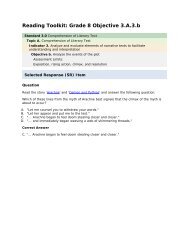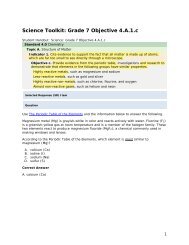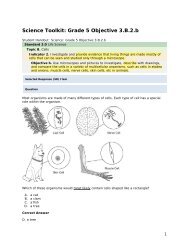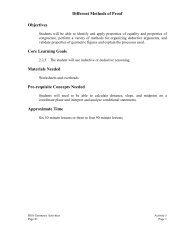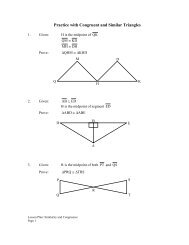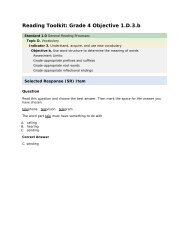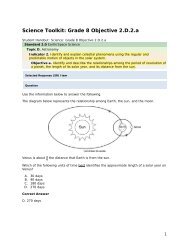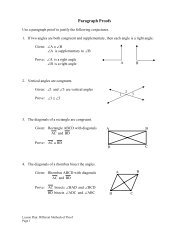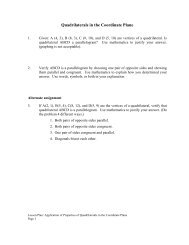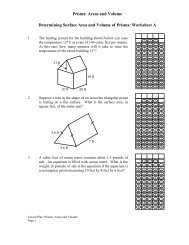Regulation of Enzyme Activity - mdk12
Regulation of Enzyme Activity - mdk12
Regulation of Enzyme Activity - mdk12
You also want an ePaper? Increase the reach of your titles
YUMPU automatically turns print PDFs into web optimized ePapers that Google loves.
<strong>Regulation</strong><br />
<strong>of</strong><br />
<strong>Enzyme</strong> <strong>Activity</strong><br />
Michelle Thornton<br />
High School Biology Teacher<br />
Linganore High School<br />
Frederick County, Maryland<br />
1
Overview<br />
<strong>Regulation</strong> <strong>of</strong> <strong>Enzyme</strong> <strong>Activity</strong><br />
Michele Thornton<br />
High School Biology<br />
This is a unit which covers the effects <strong>of</strong> various factors on the activity <strong>of</strong> enzymes. It is also a<br />
means <strong>of</strong> reinforcing the process skills involved in the scientific method.<br />
To introduce the topic and unit, two activities can be used: “<strong>Enzyme</strong> Specificity” or “Pineapple/Jell-<br />
O TM Lab”. There are three choices for the Exploration: “Beano and Lactaid Action”, “Teaching<br />
<strong>Enzyme</strong> Action Using CBL Technology” and “Pro<strong>of</strong> <strong>of</strong> <strong>Enzyme</strong> Action”. It is recommended that<br />
students perform at least two <strong>of</strong> these activities, one <strong>of</strong> which should be the CBL laboratory to introduce<br />
students to the use <strong>of</strong> current technology to gather data. The complete activity is not included here,<br />
however the teacher can easily locate the source document (see the URL on pages 10 and 19). An<br />
Extension activity can also be obtained at the same site. Assessment items are included in the Evaluation<br />
section that mirror those that are found in the State High School Assessment.<br />
The unit covers the following concepts and topics:<br />
• The correlation between the structure and function <strong>of</strong> biologically<br />
important molecules and their relationship to cell processes, specifically, factors<br />
that affect enzyme activity:<br />
� temperature,<br />
� pH,<br />
� concentration <strong>of</strong> enzyme<br />
• Posing scientific questions and suggesting experimental procedures<br />
• Carrying out investigations and employing instruments and materials<br />
• Analyzing data<br />
• Communicating information<br />
• Using mathematical processes<br />
• Connecting biology to mathematics and real-world applications<br />
2
Suggested Materials<br />
5% Sugar solutions<br />
Amylase solution<br />
Beakers<br />
Benedict’s solution<br />
Blender<br />
Calf’s liver – fresh (OR substitute raw white potato)<br />
Card stock<br />
CBL/TI System<br />
Cheesecloth<br />
Distilled water<br />
Envelopes<br />
Erlenmeyer flasks - 125 mL (OR substitute 250 mL)<br />
Eye droppers (pipettes)<br />
Food cards<br />
Gelatin cubes<br />
Glucose test paper<br />
Graduated cylinders<br />
Hot plate<br />
Hydrogen peroxide solution (3%)<br />
Locks and keys (15 assorted)<br />
pH buffers (pH 4, 7, and 10)<br />
Pestle (or device for macerating liver)<br />
Pineapple juice (canned)<br />
Pineapple juice (fresh or frozen)<br />
Potassium iodide solution (I2KI)<br />
Shallow dish or pan<br />
Starch solution<br />
Vernier Gas Pressure Sensor<br />
Vernier Temperature Probe or Thermometer<br />
Yarn<br />
Yeast suspension<br />
* Refer to “Beano and Lactaid” Lab for<br />
complete list <strong>of</strong> required materials.<br />
* Refer to “<strong>Enzyme</strong> Action: Testing Catalase<br />
<strong>Activity</strong>” Lab for complete list <strong>of</strong> required<br />
materials.<br />
* Refer to “Pro<strong>of</strong> <strong>of</strong> <strong>Enzyme</strong> Action” Lab for for<br />
complete list <strong>of</strong> required materials.<br />
* Refer to “Teaching <strong>Enzyme</strong> Action Using CBL<br />
Technology” Lab for complete list <strong>of</strong> required<br />
materials.<br />
*NOTE: This list <strong>of</strong> materials is NOT complete. Teachers should refer to the actual lab references for a<br />
complete list <strong>of</strong> required materials.<br />
3
LESSON COMPONENTS SUGGESTED ACTIVITIES<br />
I. Engagement:<br />
The activities in this<br />
section capture the<br />
students’ attention,<br />
stimulate their<br />
thinking, and help<br />
them access<br />
prior knowledge.<br />
II. Exploration:<br />
In this section,<br />
students are given<br />
time to think, plan,<br />
investigate, and<br />
organize collected<br />
information.<br />
III. Explanation:<br />
Students are now<br />
involved in an<br />
analysis <strong>of</strong> their<br />
exploration. Their<br />
understanding is<br />
clarified and<br />
modified because <strong>of</strong><br />
reflective activities.<br />
IV. Extension:<br />
This section gives<br />
students the<br />
opportunity to<br />
expand and solidify<br />
their understanding<br />
<strong>of</strong> the concept and/or<br />
apply it to a real<br />
world situation.<br />
V. Evaluation:<br />
This performance-<br />
based helps the<br />
students to connect all<br />
<strong>of</strong> the pieces <strong>of</strong><br />
information involved in<br />
these lessons.<br />
I. <strong>Enzyme</strong> Specificity Class <strong>Activity</strong><br />
and/or Pineapple/Jell-O Lab<br />
CLG: 1.2.1, 1.2.2, 3.1.1, 3.1.2<br />
II. Beano and Lactaid Action Lab, by Vernier<br />
or Teaching <strong>Enzyme</strong> Action Using CBL Technology,<br />
or Pro<strong>of</strong> <strong>of</strong> <strong>Enzyme</strong> Action Lab<br />
CLG: 1.2.3, 1.2.5, 1.3.1, 1.3.2, 1.3.3, 1.4 (exc. ind. 5),<br />
1.5.1–1.5.4, 1.6.1, 1.6.4, 1.7.1, 3.1.1, 3.1.2<br />
III. Students will be guided through a discussion <strong>of</strong><br />
enzyme action (enzymes, substrates, coenzymes)<br />
based upon Section II activities.<br />
CLG: 1.2.5, 3.1.1, 3.1.2<br />
IV. <strong>Enzyme</strong> Action: Testing Catalase <strong>Activity</strong> (Vernier),<br />
Observing the Effect <strong>of</strong> Concentration on <strong>Enzyme</strong><br />
<strong>Activity</strong>, Observing the Effect <strong>of</strong> Temperature on<br />
<strong>Enzyme</strong> <strong>Activity</strong><br />
CLG: 1.2.3, 1.2.5, 1.3.1, 1.3.2, 1.3.3, 1.4 (exc. ind. 5),<br />
1.5.1–1.5.4, 1.6.1, 1.6.4, 1.7.1, 3.1.1, 3.1.2<br />
V. <strong>Enzyme</strong> Graph Application: Provides students with a<br />
data set comparing time to enzyme concentration. Students<br />
will create and analyze their graph, and predict the effect <strong>of</strong><br />
a change in enzyme concentration, pH or<br />
temperature on enzyme activity.<br />
CLG: 1.1.2, 1.4.2, 1.4.4, 1.5.1, 1.5.2, 3.1.2, 3.2.2<br />
Notes/Comments<br />
• Addresses concept <strong>of</strong> <strong>Enzyme</strong>s/Substrates/<strong>Regulation</strong><br />
• Possible assessment items can be found at the end <strong>of</strong> this packet.<br />
4
I. ENGAGEMENT<br />
“<strong>Enzyme</strong> Specificity: Introduction to <strong>Enzyme</strong>s”<br />
Rationale:<br />
• To illustrate the specificity <strong>of</strong> enzyme action<br />
Time:<br />
• Approximately 30 minutes<br />
Objectives:<br />
• To introduce students to the concept <strong>of</strong> enzyme and substrate reactions<br />
Materials: (for class <strong>of</strong> 30)<br />
• Assorted locks/keys (15)<br />
• Food Cards<br />
• Card stock and envelopes<br />
• Yarn<br />
Overview:<br />
• Students will use locks and matching keys to represent enzymes and substrates in<br />
human digestion.<br />
Procedure:<br />
1. Fifteen students (or half <strong>of</strong> the class) are chosen to represent food items.<br />
2. Each student is given a sealed envelope with the name <strong>of</strong> the food item on it to wear.<br />
3. Students then line up according to food item type (which is indicated on the outside <strong>of</strong><br />
the envelope).<br />
4. Each <strong>of</strong> these students is also given a specific lock.<br />
5. Fifteen other students (or remaining class members) are given keys.<br />
6. Students mingle attempting to match locks and keys.<br />
7. When a key opens a lock, the pair <strong>of</strong> students returns to their original position in line.<br />
8. After all locks and keys are matched, each person representing a food person opens<br />
his/her card and shares the enzyme/substrate information on the card with the class.<br />
5
Food/<strong>Enzyme</strong> Chart<br />
1. Coke- sucrose/sucrase<br />
2. French fries- polysaccharide/amylase & lipid/lipase<br />
3. Hamburger-<br />
bun- polysaccharide/amylase & nucleic acid/nuclease<br />
pickles- cellulose/cellulase<br />
cheese- lipid/lipase and protein/protease & lactose/lactase<br />
beef patty- protein/protease & lipid/lipase<br />
ketchup- sucrose/sucrase<br />
mustard- sucrose/sucrase<br />
4. Ice cream- maltose/maltase, lipid/lipase, and lactose/lactase<br />
1. Carbohydrates:<br />
Sucrose - sucrase<br />
Maltose - maltase<br />
Lactose - lactase<br />
Polysaccharides - amylase<br />
Cellulose – cellulase<br />
2. Proteins – protease<br />
3. Lipids – lipase<br />
4. Nucleic Acids – nuclease<br />
<strong>Enzyme</strong>/Food Matches<br />
6
Category <strong>of</strong> Food Matching Food No. <strong>of</strong> Locks<br />
A. Carbohydrates<br />
1. Sucrose Coke 2 identical<br />
Ketchup/Mustard<br />
2. Maltose Ice Cream 1<br />
3. Lactose Ice Cream 2 identical<br />
Cheese<br />
4. Polysaccharides Fries 2 identical<br />
Bun<br />
5. Cellulose Pickle 1<br />
B. Proteins Beef Patty 2 identical<br />
Cheese<br />
C. Lipids Beef Patty 4 identical<br />
Cheese<br />
Ice Cream<br />
Fries<br />
D. Nucleic Acids Bun 1 lock<br />
7
SODA (on exterior <strong>of</strong> envelope)<br />
INFORMATION FOR FOOD CARDS<br />
(Inside envelope) Disaccharides are carbohydrates essential in supplying the body with<br />
energy. The energy contained in a disaccharide is released only when it is broken down by an<br />
enzyme. This enzymatic reaction takes place in the stomach and small intestine.<br />
A glass <strong>of</strong> soda can contain up to 50 grams <strong>of</strong> sucrose. Sucrose is a type <strong>of</strong><br />
disaccharide that is composed <strong>of</strong> glucose molecules that are chemically bonded to fructose<br />
molecules. The only key that unlocks sucrose is sucrase.<br />
KETCHUP/MUSTARD<br />
Although, ketchup and mustard contain tomatoes and mustard seeds, respectively,<br />
their primary ingredients are sugar and water! The sugar that is most commonly found in both<br />
ketchup and mustard is sucrose. The only key that unlocks sucrose is sucrase.<br />
ICE CREAM (1)<br />
Ice cream is a colloid, a suspension <strong>of</strong> sugar molecules in frozen fat. Maltose is one<br />
type <strong>of</strong> sugar that may be found in ice cream. Maltose is a second type <strong>of</strong> disaccharide.<br />
Maltose molecules are formed from two glucose molecules that are chemically bonded. The<br />
only key that unlocks maltose is maltase.<br />
CHEESE (1)<br />
A type <strong>of</strong> sugar that is always found in cheese and other dairy products is lactose. Lactose is a<br />
third type <strong>of</strong> disaccharide. Lactose, is composed <strong>of</strong> glucose molecules that are chemically<br />
bonded to galactose molecules. Some people lack the enzyme required to break down<br />
lactose. We say that those people are “lactose intolerant.” The only key that unlocks lactose<br />
is lactase.<br />
ICE CREAM (2)<br />
Since ice cream is a dairy product, it also contains lactose. Lactose that is not broken<br />
down by the body’s natural lactose is fermented by bacteria in the intestine. This process can<br />
produce large quantities <strong>of</strong> gas. The only key that unlocks lactose is lactase.<br />
FRENCH FRIES (1)<br />
French fries are made from potatoes. Potatoes are filled with starch. Plants<br />
produce starch as a way to store extra energy. Starch is a polysaccharide containing<br />
long chains <strong>of</strong> repeating units <strong>of</strong> glucose. One enzyme that unlocks starch is amylase.<br />
8
BUN (1)<br />
Buns contain starch and other complex carbohydrates. Starches are broken down by<br />
amylase. Amylase is found in saliva, so digestion starts the moment you begin<br />
to chew. Amylase is also produced by the pancreas. One enzyme that unlocks<br />
starch is amylase.<br />
PICKLE<br />
Pickles and all other vegetables contain the polysaccharide, cellulose.<br />
Cellulose is important in the structure <strong>of</strong> the cell wall <strong>of</strong> plants. Although cattle and other<br />
herbivores have the ability to digest cellulose, human beings lack the enzyme needed to break<br />
down cellulose. Therefore, cellulose passes undigested from the body human body. Cellulose<br />
provides the fiber or roughage that is an important component <strong>of</strong> the human diet. The only key<br />
that unlocks cellulose is cellulase.<br />
BEEF PATTY (1)<br />
Meat is the muscle tissue <strong>of</strong> an animal. Meat is composed primarily <strong>of</strong> proteins, which<br />
are, in turn, composed <strong>of</strong> amino acids. Like the letters <strong>of</strong> the alphabet, which are combined in<br />
nearly infinite ways to form words, amino acids are combined to form proteins. There are<br />
thousands <strong>of</strong> different proteins yet only 20 different amino acids. The enzymes that unlock<br />
proteins are collectively called proteases. The only key<br />
that unlocks a protein is a protease.<br />
CHEESE (2)<br />
The protein that is found in cheese was assembled by a cow from the amino acids she<br />
consumed in her diet. After digesting protein, humans also reassemble the component amino<br />
acids into human proteins; thus, the expression, “You are what you eat.” The only<br />
key that unlocks a protein is a protease.<br />
BEEF PATTY (2)<br />
As much as 30% <strong>of</strong> a beef patty is fat. This fat was stored by a cow for its future<br />
energy needs. The excess fat that we eat goes directly to OUR storage areas. The group <strong>of</strong><br />
enzymes that break down lipids are called lipases. The only key that unlocks a<br />
lipid (fat) is a lipase.<br />
CHEESE (3)<br />
Cheese is made from the fat that is skimmed from the surface <strong>of</strong> raw milk (milk that has<br />
not been homogenized). In fact, the main ingredient in cheese is milk fat. Fat is a lipid. The<br />
only key that unlocks a lipid is a lipase.<br />
9
ICE CREAM (3)<br />
When raw milk settles, cream floats to the top. This cream is used to make ice cream.<br />
When milk is used instead, the product is called “ice milk.” Ice milk contains less fat than ice<br />
cream. Cream is a lipid. The only key that unlocks a lipid is a lipase.<br />
FRENCH FRIES (2)<br />
Although potatoes contain no fat, french fries are among the fattiest <strong>of</strong> foods<br />
that you can eat. The fat is added when the potato strips are deep-fried. The only<br />
key that unlocks a lipid is a lipase.<br />
BUN (2)<br />
Nucleic acids include DNA and RNA, the molecules that provide the<br />
“blueprints” for all organisms. Because they are found in all living things, nucleic acids are<br />
present in all foods. The enzymes that break down nucleic acids are called nucleases. The<br />
only key that unlocks a nucleic acid is a nuclease.<br />
10
I. ENGAGEMENT<br />
“Pineapple/Jell-O TM Lab”<br />
Rationale:<br />
• To show that food items contain enzymes.<br />
Time:<br />
• Approximately 30 minutes<br />
Objectives:<br />
• To introduce students to the concept <strong>of</strong> enzyme and substrate reactions<br />
Materials: (for class <strong>of</strong> 30)<br />
• Prepared 2-3 cm Jell-O TM Brand gelatin cubes (4-5 cubes per group)<br />
• Shallow dish or pan<br />
• Fresh and canned pineapple juice<br />
• Blender<br />
• Cheesecloth<br />
Overview:<br />
• Students will use pineapple juice as an enzyme and Jell-O TM as a substrate to<br />
illustrate an enzyme/substrate complex.<br />
• Students will discover that the processing <strong>of</strong> food will denature enzymes.<br />
Procedure:<br />
1. Teacher or students prepare Jell-O TM the day before this activity.<br />
2. Teacher or students prepare fresh pineapple juice by pureeing fresh<br />
pineapple in a blender. The puree should be strained through cheesecloth to<br />
separate the pulp from the juice. Repeat this procedure for the canned<br />
pineapple.<br />
3. Student groups receive a sample <strong>of</strong> either fresh or canned pineapple juice<br />
and cubes <strong>of</strong> Jell-O TM .<br />
4. Place Jell-O TM cubes in a shallow dish or pan.<br />
5. Pour juice sample over the Jell-O TM cubes until the bottom <strong>of</strong> the dish or pan<br />
is covered.<br />
6. Students should observe the experimental set-up for 30 minutes and record<br />
observations at 5 minute intervals.<br />
11
For additional information and optional activities see the following resources:<br />
Access Excellence –<br />
http://www.gene.com/ae<br />
“Catalysis Using <strong>Enzyme</strong>s in Pineapple” –<br />
http://www.woodrow.org/teachers/chemistry/institutes/1986/exp22.html<br />
Background information:<br />
1. Gelatin is made from a protein called collagen which comes from the joints <strong>of</strong><br />
animals. Gelatin may be dissolved in hot water. As the dissolved gelatin mixture<br />
cools, the collagen forms into a matrix that traps the water; as a result, the mixture<br />
turns into the jiggling semi-solid mass that is so recognizable as Jell-O TM .<br />
2. Pineapple belongs to a group <strong>of</strong> plants called Bromeliads. Kiwi, papaya, and figs<br />
are other types <strong>of</strong> Bromeliads. The enzyme in pineapple juice that is responsible for<br />
the breakdown <strong>of</strong> collagen is bromelin. The process <strong>of</strong> canning pineapple denatures<br />
the bromelin, rendering it incapable <strong>of</strong> catalyzing the break down <strong>of</strong> gelatin.<br />
12
II. EXPLORATION<br />
“Beano and Lactaid Action”<br />
Rationale:<br />
• To show the action <strong>of</strong> two different commercially prepared enzymes, Beano<br />
and Lactaid.<br />
Time:<br />
• Approximately 30-40 minutes for 1 trial<br />
Objectives:<br />
• To test the action <strong>of</strong> two commercial products, Beano and Lactaid<br />
• To use glucose test paper to monitor the presence <strong>of</strong> glucose<br />
• To determine if yeast can metabolize glucose, lactose, or galactose<br />
• To determine if yeast can metabolize glucose, lactose, or galactose in the<br />
presence <strong>of</strong> Beano or Lactaid<br />
Materials:<br />
• CBL/TI system<br />
• Vernier Gas Pressure Sensor<br />
• glucose test paper<br />
• 5% sugar solutions<br />
• yeast suspension<br />
• see lab for other materials<br />
Overview:<br />
• Students will monitor CO2 production for evidence <strong>of</strong> fermentation in yeast<br />
with and without the help <strong>of</strong> commercial enzymes.<br />
Procedure:<br />
See Holman, S. and Masterman, D. Biology with CBL. “Beano and Lactaid<br />
Action.” Vernier S<strong>of</strong>tware, 1997. 24-1 through 24-7,<br />
http://www.vernier.com/cmat/BWCBL.html<br />
13
EXPLORATION (Alternative)<br />
“Teaching <strong>Enzyme</strong> Action Using CBL Technology”<br />
Rationale:<br />
• To explore the reaction rate <strong>of</strong> the enzyme, catalase, on the breakdown <strong>of</strong><br />
hydrogen peroxide<br />
Time:<br />
• Approximately 30-40 minutes<br />
Objectives:<br />
• To measure the action <strong>of</strong> an enzyme (catalase) on its substrate (hydrogen<br />
peroxide)<br />
• To prepare a catalase solution from fresh liver<br />
• To collect data using a CBL.<br />
Materials:<br />
• CBL/TI system<br />
• Vernier Gas Pressure Sensor<br />
• fresh liver<br />
• hydrogen peroxide<br />
• see lab for additional materials<br />
Overview:<br />
1. Students will monitor the reaction by recording pressure changes as oxygen<br />
gas is given <strong>of</strong>f during the reaction.<br />
Procedure:<br />
See Thornton, M. 1998. “Teaching <strong>Enzyme</strong> Action Using CBL Technology.”<br />
(Attachment follows)<br />
14
BIOLOGY CBL LAB<br />
ENZYME CATALYSIS: CATALASE<br />
PURPOSE:<br />
To demonstrate the action <strong>of</strong> the enzyme catalase. Harmful hydrogen peroxide forms within<br />
many cells. The enzyme catalase catalyzes the breakdown <strong>of</strong> hydrogen peroxide according to<br />
the reaction shown below:<br />
2H2O2 2H2O + O2<br />
We will monitor the reaction by recording pressure changes as oxygen gas is given <strong>of</strong>f during<br />
the reaction.<br />
MATERIALS:<br />
CBL TI-82/83 Calculator<br />
Erlenmeyer Flask Pressure Sensor (PS-DIN)<br />
Pipettes 1.5% solution <strong>of</strong> H2O2<br />
1-holed rubber stopper to fit flask, Catalase solution prepared from fresh calf’s<br />
fitted with glass tube liver or potato (must be kept on ice)<br />
TEACHER PREPARATION<br />
1. Preparation <strong>of</strong> Hydrogen Peroxide Solution (H2O2)<br />
• Hydrogen Peroxide can be purchased from the grocery store or pharmacy in a 3.0%<br />
concentration.<br />
• Dilute it to 1.5% by adding an equal volume <strong>of</strong> distilled water. You will need 10 mL <strong>of</strong><br />
H2O2 per laboratory set-up.<br />
2. Preparation <strong>of</strong> <strong>Enzyme</strong> Solution (Catalase)<br />
A solution <strong>of</strong> catalase can be made from fresh calf’s liver. Use the following procedure:<br />
• Macerate a small 2 – 3 cm 2 piece <strong>of</strong> fresh calf’s liver in a beaker.<br />
• Add 100 mL <strong>of</strong> ice cold distilled water and stir.<br />
• Filter the mixture through cheesecloth. The color <strong>of</strong> the resulting filtrate should be light<br />
pink.<br />
• An alternative source <strong>of</strong> catalase is raw white potato. Repeat the procedure above<br />
using similar size pieces <strong>of</strong> raw white potato.<br />
3. Set-Up <strong>of</strong> Erlenmeyer Flask<br />
• Select an Erlenmeyer flask that can be stoppered snugly with a 1-holed rubber stopper.<br />
(A 125 mL flask is recommended, however, a 250 mL flask can be used. If the larger<br />
flask is used, the quantities <strong>of</strong> solutions will have to be doubled.)<br />
• Insert the glass portion <strong>of</strong> an eyedropper (pipette) through the hole in the stopper so<br />
that the point <strong>of</strong> the dropper faces up. This set-up will permit the Tygon tubing <strong>of</strong> the<br />
CBL probe to fit onto the top <strong>of</strong> the eyedropper.<br />
15
STUDENT LAB<br />
A. SETTING UP THE TI-82, CBL, AND PRESSURE SENSOR<br />
• Connect the CBL unit to the TI-82/83 graphing calculator using the unit-to-unit link<br />
cable and the I/O ports located at the bottom edge <strong>of</strong> each unit.<br />
• Connect the Vernier Pressure Sensors to the Channel 1 port located at the top edge<br />
<strong>of</strong> the CBL unit.<br />
B. ENTERING THE PROGRAM<br />
• Press “ON” to turn on your CBL.<br />
• Press “ON” to turn on your TI-82/83 calculator.<br />
• Press the PRGM button.<br />
• Choose “CHEMBIO” from the menu.<br />
• Press ENTER three times.<br />
C. SETTING UP PROBES<br />
• Choose “SET UP PROBES.”<br />
• “ENTER NUMBER OF PROBES” will appear. Press “1” and then ENTER.<br />
• Choose “PRESSURE” for type <strong>of</strong> probe.<br />
• “USE LOWEST AVAILABLE CHANNELS. ENTER CHANNEL NUMBER” will<br />
appear. Press “1” and then ENTER.<br />
• Choose “USE STORED” to set calibration. Press ENTER.<br />
• Choose “mmHg” for units.<br />
*** BEFORE PROCEEDING, PLEASE READ THE INFORMATION BELOW ***<br />
RUNNING THE EXPERIMENT<br />
D. Time Set up<br />
• Choose “COLLECT DATA.” Press ENTER.<br />
• Choose “TIME GRAPH.“ Press ENTER.<br />
• “TIME BETWEEN SAMPLES IN SECONDS” will appear. Press “2” and then press<br />
ENTER.<br />
• “NUMBER OF SAMPLES” will appear. Press “90” and then press ENTER.<br />
• “SAMPLE, TIME 2.00 S: SAMPLES 90; EXPERIMENT LENGTH 180.00 S” will<br />
appear. Press ENTER.<br />
• Choose “USE TIME SETUP.” Press ENTER.<br />
• “SET Y-AXIS Ymin=?” will appear. Press “700” and then press ENTER .<br />
• “Y max=?” will appear. Press “1100” and then press ENTER.<br />
• “Y scl=?” will appear. Press “50” and then press ENTER.<br />
• “PRESS ENTER TO BEGIN COLLECTING DATA” will appear . . . BUT . . .<br />
Don’t press ENTER ENTER ... not yet!!!<br />
16
D. Using a 10 mL pipette and pump, place 10 mL <strong>of</strong> 1.5% hydrogen peroxide solution<br />
into the 125 mL flask (or use 20 mL H2O2 in a 250 mL flask). Attach the Tygon<br />
tubing <strong>of</strong> the PRESSURE probe to the glass tube in the rubber stopper. Open the<br />
valve so that the vial and outside air are continuous (the stopcock should be<br />
parallel to the Tygon tubing and facing the pressure sensor box). (The blue<br />
nozzle will be parallel to the tubing rubber.)<br />
E. Using a 1 mL pipette and pump, add 1 mL (or 2 mL if using 20 ml H2O2 ) <strong>of</strong><br />
catalase solution to the flask. Cover the flask with the stopper/glass<br />
tube/Tygon tubing apparatus.<br />
G. Close the valve (turn the blue stopcock so that it is perpendicular to the Tygon<br />
tubing) and press ENTER to start the experiment. The CBL/Calculator/TI-82 will<br />
take and display the pressure readings every 2 seconds. Do not move the<br />
apparatus since movement may cause small pressure fluctuations.<br />
H. When the CBL reads DONE, the experiment is over. The calculator screen will<br />
show “TIME IN L1 ; Pressure in L2.”<br />
I. Press ENTER ENTER ENTER to see a rough copy <strong>of</strong> the graph. Please show this graph to your<br />
teacher to determine if the procedure needs to be repeated.<br />
J. To see data from the 90 points that were collected, press ENTER ENTER. ENTER When the<br />
screen asks if you want to repeat, press NO. At the next menu press “QUIT.”<br />
You should now have a blank screen.<br />
K. On the calculator, press “STAT”; under the new menu, choose “EDIT”. Your data<br />
should appear under L1 and L2 . Take the calculator to the computer to create a<br />
graph that can be printed out.<br />
TRANSFERRING DATA FROM TI-82/83 CALCULATORS<br />
TO GRAPHICAL ANALYSIS<br />
1. Connect the GraphLink TM cable to the modem (phone) serial port on the back<br />
<strong>of</strong> the computer.<br />
2. Start up the Graphical Analysis TM program (Mac version 2.0.3 or higher) on the<br />
computer.<br />
3. Firmly insert the GraphLink TM cable into the data port on the calculator.<br />
4. On the computer, pull down the menu under “File to Import” from TI-82/83/85.<br />
5. On the calculator, press the 2 nd key, then the “LINK” key.<br />
17
If you are using a TI-82:<br />
1. Choose “2: SelectAll-“<br />
2. Mark the Lists you want to send by moving the them with the arrows, and<br />
pressing the ENTER ENTER key. A mark will appear next to the marked lists.<br />
3. Use the ▶ key to move over to “TRANSMIT."<br />
4. Press the ENTER ENTER key to send the data to the computer.<br />
If you are using a TI-83:<br />
1. Choose Lists<br />
2. Mark the Lists you want to send by moving the cursor you them with the arrows,<br />
and pressing the ENTER ENTER key. A mark will appear next to the marked lists.<br />
3. Use the ► key to move over to “TRANSMIT.”<br />
4. Press the ENTER ENTER key to send the data to the computer.<br />
GRAPHICAL ANALYSIS<br />
1. You will need to rename the axis and add labels.<br />
2. Click on “L1” , in the Data window. Type the label for the X axis.<br />
3. In the box below, add the units for the X axis.<br />
4. Repeat for the data in the next column (possibly L2 ) for the Y axis.<br />
5. Rename your graph using “Rename Graph” under the “GRAPH” menu. If you are<br />
printing on a network or shared printer, add your initials to the graph title.<br />
6. To fit a regression line to linear data select “Regression Line” and/or “Regression<br />
Statistics” from under the “GRAPH” menu.<br />
7. You can have the “Graphical Analysis” feature automatically fit a curve to the data.<br />
Select “Automatic Curve Fit” under the “ANALYZE” menu.<br />
18
RESCALING AXES<br />
1. Click once on the number at the end <strong>of</strong> each axis.<br />
2. Enter a new value. Graphical Analysis will automatically rescale the axis.<br />
PRINTING<br />
1. Graphical Analysis will print the active window. To make a window active, just click on<br />
it.<br />
2. Select “Print Graph” from the “FILE” menu.<br />
CREATING MULTIPLE GRAPHS ON GRAPHICAL ANALYSIS<br />
1. To create another line on your graph, you need to download data to a “New Data Set”.<br />
Create this set by using the command under the “DATA” menu.<br />
2. Graphical Analysis will create a new line with new point protectors. To enhance your<br />
graph, add a legend to your graph. The command is under the “GRAPH” menu.<br />
3. Rename your data sets to improve your graph (check under the “DATA” menu).<br />
19
QUESTIONS<br />
1. How is pressure used in this experiment? What is the pressure really measuring?<br />
2. Relate the shape <strong>of</strong> the graph to the amount <strong>of</strong> O2 released and the amount <strong>of</strong> H2O2<br />
broken down.<br />
3. If you continued the lab without disturbing the set up for 2 minutes longer, what<br />
prediction could you make about the shape <strong>of</strong> the graph?<br />
4. The shape <strong>of</strong> the graph will change if changes are made in the H2O2 or catalase<br />
solutions.<br />
• Identify the changes that could be made in each solution.<br />
• Explain how each change will affect the shape <strong>of</strong> the graph.<br />
20
EXPLORATION (Alternative)<br />
“Pro<strong>of</strong> <strong>of</strong> <strong>Enzyme</strong> Action”<br />
Rationale:<br />
• To explore the effect <strong>of</strong> an enzyme on its substrate.<br />
Time:<br />
• Approximately 45 minutes<br />
Objectives:<br />
• To use models to demonstrate the effect <strong>of</strong> an enzyme on its substrate<br />
(starch molecules will be broken down into their component monosaccharide<br />
units).<br />
• To use Benedict’s solution to test for the presence <strong>of</strong> starch and glucose<br />
• To look for evidence <strong>of</strong> enzyme action by testing an starch/amylase solution<br />
Materials:<br />
• starch solution<br />
• Benedict’s solution<br />
• iodine solution<br />
• amylase<br />
• hot plate<br />
• see lab for additional materials<br />
Overview:<br />
• Students will use models to illustrate enzyme action.<br />
• Students will test a starch solution with iodine and Benedict’s solution<br />
• Students will test a starch/amylase solution with iodine and Benedict’s<br />
solution<br />
Procedure:<br />
See Kaskel, A, Hummer, Jr. P., et al. 1994. Investigating Living Systems-<br />
Laboratory Manual. “Pro<strong>of</strong> <strong>of</strong> <strong>Enzyme</strong> Action.” Glencoe. 35-38.<br />
IV. EXTENSION<br />
21
“<strong>Enzyme</strong> Action: Testing Catalase <strong>Activity</strong>”<br />
Rationale:,<br />
• To explore the effect <strong>of</strong> changes in enzyme concentration, temperature, and<br />
pH on enzyme activity<br />
Time:<br />
• Approximately 45 minutes<br />
Objectives:<br />
• To test the effect <strong>of</strong> the concentration <strong>of</strong> catalase on the enzymatic<br />
breakdown <strong>of</strong> hydrogen peroxide<br />
• To test the effect <strong>of</strong> pH on the enzymatic breakdown <strong>of</strong> hydrogen peroxide<br />
• To test the effect <strong>of</strong> temperature on the enzymatic breakdown <strong>of</strong> hydrogen<br />
peroxide<br />
Materials:<br />
• CBL/TI system<br />
• Vernier Biology Gas Pressure Sensor<br />
• temperature probe or thermometer<br />
• hydrogen peroxide<br />
• fresh calf’s liver<br />
• water bath<br />
• pH buffers (4, 7, and 10)<br />
• see lab for additional materials<br />
Overview:<br />
• Student groups will measure the effect <strong>of</strong> enzyme concentration, pH, or<br />
temperature on the breakdown <strong>of</strong> hydrogen peroxide by catalase.<br />
• Data will be shared among groups.<br />
• Students will compare experimental results to conditions normally found in the<br />
human body.<br />
Procedure:<br />
See Holman, S., Masterman, D. Biology with CBL. “<strong>Enzyme</strong> Action: Testing<br />
Catalase <strong>Activity</strong>.” Vernier S<strong>of</strong>tware, 1997. 6-1 through 6-6.<br />
http://www.vernierkorea.com/exper/sample/bio/101.pdf<br />
V. Evaluation<br />
22
“Factors That Affect the <strong>Activity</strong> <strong>of</strong> <strong>Enzyme</strong>s”<br />
A student conducted an experiment to measure the reaction rate <strong>of</strong> the enzyme catalase on<br />
a solution <strong>of</strong> hydrogen peroxide. In this reaction, the enzyme facilitates the breakdown <strong>of</strong><br />
hydrogen peroxide into water and oxygen. The reaction is illustrated by the following chemical<br />
equation:<br />
2H2O2 2H2O + O2<br />
The release <strong>of</strong> oxygen causes a change in pressure which can be measured by a CBL<br />
apparatus. Data from this reaction are shown in the table below.<br />
THE CHANGE IN PRESSURE CAUSED BY THE REACTION<br />
OF CATALASE AND HYDROGEN PEROXIDE<br />
Time Pressure<br />
(seconds) (mm Hg)<br />
0 0<br />
2 8<br />
4 16<br />
6 24<br />
8 32<br />
10 40<br />
12 48<br />
14 48<br />
16 48<br />
18 48<br />
• Use the data provided to construct a line graph <strong>of</strong> this reaction. Be sure to include all <strong>of</strong><br />
the elements specified on the “Scoring Criteria for Graphs” sheet.<br />
• Next, select one <strong>of</strong> the following variables and describe how it would affect the rate <strong>of</strong><br />
the reaction.<br />
Variables:<br />
A. The temperature drops<br />
B. The pH drops<br />
C. The substrate concentration increases<br />
• Finally, draw a dashed line on the graph to illustrate the change that would occur.<br />
23
ASSESSMENT ITEMS<br />
Selected Response Items (SRs)<br />
1. Measures CLGs 3.1.2, 3.2.2<br />
Which <strong>of</strong> these factors would cause a decrease in the enzyme activity <strong>of</strong> bacteria that<br />
live in hot springs where the temperature is 95°C and the normal pH is between 2 and<br />
4?<br />
A introducing the enzyme sucrase into the hot springs<br />
B placing the bacteria into an environment <strong>of</strong> pH 3<br />
C moving the bacteria to a temperature <strong>of</strong> 37°C<br />
D agitating the water in the hot springs<br />
Correct Response: C<br />
2. Measures CLGs 1.7.1, 3.1.1<br />
Many people lack the enzyme that allows them to digest lactose, a sugar that is found in<br />
dairy products. These people are referred to as “lactose-intolerant.” The enzyme that<br />
will allow them to digest lactose is<br />
A amylase<br />
B galactase<br />
C lactase<br />
D protease<br />
Correct Response : C<br />
Brief Constructed Response Items (BCRs)<br />
1. Measures CLGs 1.2.5, 1.5.1, 3.1.2, 3.2.2<br />
A change in temperature from 37°C to 45°C would affect the activity <strong>of</strong> catalase, a<br />
common enzyme found in liver.<br />
• Describe how the structure <strong>of</strong> the enzyme would be affected<br />
• Describe how the function <strong>of</strong> the enzyme would be affected<br />
Answer Cues: Students should discuss the idea that if this increase in temperature were<br />
to occur, the enzyme would be denatured thus rendering it inactive. The 3-D<br />
structure <strong>of</strong> the enzyme would be changed. Students may also say that the<br />
shape <strong>of</strong> the active site would be changed. They may also relate this to the<br />
lock and key activity completed in the Engagement section where the shape <strong>of</strong><br />
the key determines its fit into the lock.<br />
24
2. Measures CLGs 1.4.8, 1.5.1, 3.1.1<br />
Construct a possible model for the enzyme that could break down Molecule A drawn<br />
below. Describe why this same enzyme cannot break down Molecule B.<br />
Molecule A Molecule B<br />
Answer Cues: Students should sketch a an enzyme that “fits” the given model <strong>of</strong> Molecule A.<br />
Students should also discuss why this enzyme cannot break down Molecule B.<br />
This explanation should discuss the specificity <strong>of</strong> enzymes, a certain enzyme<br />
can only bind to a specific substrate.<br />
Extended Constructed Response Item (ECR)<br />
1. Measures CLGs 1.4.1, 1.4.2, 1.5.2, 3.1.1, 3.1.2<br />
<strong>Enzyme</strong>s function in a narrow range <strong>of</strong> pH.<br />
• Describe the effect <strong>of</strong> a change in pH on the activity <strong>of</strong> a particular enzyme.<br />
• Construct a graph which shows the expected change in activity.<br />
Be sure to include all <strong>of</strong> the elements specified on the “Scoring Criteria for Graphs”<br />
sheet.<br />
Answer Cues: The graph should be appropriately labeled and the line should show a drop in<br />
enzyme activity as the pH changes. The description should explain the idea<br />
that a change in pH will denature the enzyme resulting in decreased enzymatic<br />
activity. The enzyme activity curve should be placed over the appropriate pH<br />
values on the X-axis.<br />
25


